#High-quality protein diet
Explore tagged Tumblr posts
Text
Energy supply nutrients for the human body: amino acids, proteins, enzymes
Proteins make up about 20% of the human body and are found in every cell. The word protein is a Greek word that means “most important”. Proteins are called the workhorses of life because they provide structure to the body and perform a variety of functions. Because muscles are rich in protein, you can dance, run, play racquetball, hula hoop, etc. Proteins are necessary for the proper function of…

View On WordPress
0 notes
Text
















the cast of mianite as onion headlines, part 2
(sources: 1 2 3)
#THERE we go. thats all of them. cant believe i made 46 of these damn lol anyways#apollo's tag#mcyt#mianite#undescribed#there you go guys that's your food for the next two months. should be enough to keep yall going for a while#these types of shitposts are low in quality but high in protein#essential to any fan's diet
44 notes
·
View notes
Text

A dish we all love and something that we eagerly look forward to eating, prawns are simply one of the best kinds of seafood out there! They have a subtle yet greatly enjoyable taste and the fact that they can be cooked in a variety of ways is just the icing on top of the cake! Prawns straddle a fine line between being regularly incorporated into diets and being a delicacy. However, with the vast range of health benefits on offer, we’d suggest you eat it regularly rather than once in a blue moon. Still not convinced, here are 5 health benefits to eating fresh prawns!
0 notes
Text
Ah yes, the classic solution to every problem of:
'You have a problem? Just starve, idiot.'




Needless to say, looking up recipes to help with my autoimmune issues is going FANTASTIC and totally NOT making me want to commit arson
#there are a lot of really ducked up ''''diets''''' out there.#there have been studies that show intermittent fasting can help with issues like these#when done safely and carefully with high quality macronutrients as the main calorie#and it actually encourage higher calorie consumption for better results#all things being relative of course#not telling you to eat six bags of chips for dinner#but substitute the noodles for vegetables and add some extra protein kinda thing#but yeah...#this sucks.#🦆
6K notes
·
View notes
Text



healthy eating as a student
!!never say that healthy eating is unachievable for students. this is a horrible mindset that will no doubt affirm the problem.
healthy eating is important for several reasons, especially to maintain high levels of energy, focus, and overall well-being. first, it supports physical health by providing sustained energy, boosting the immune system, and aiding in weight management. nutritious foods rich in vitamins and minerals strengthen the immune system, helping to fend off common illnesses. a balanced diet also ensures steady energy levels throughout the day, preventing the mid-afternoon crashes often caused by sugary snacks or processed foods.
academically, students who eat well are likely to see enhanced focus, better grades, and consistent energy levels. balanced meals supply a steady flow of glucose to the brain, which is essential for maintaining alertness and concentration during classes and study sessions. a nutritious diet supports cognitive processes, leading to improved academic performance and outcomes.
you cannot live off of two-minute noodles.
now, here are some hacks and strategies to make healthy eating more achievable:
planning and prep
meal planning: take some time each week to plan your meals. this helps you make thoughtful choices and avoid last-minute unhealthy options.
meal planning with roommates: if you live with roommates, organizing a meal plan together can be a fantastic way to share responsibilities and ensure everyone eats healthily. take turns cooking meals, or have a weekly cook-off where each person prepares a nutritious dish.
grocery list: make a list of healthy staples and stick to it when shopping. this can include fruits, vegetables, lean proteins, whole grains, and healthy fats.
batch cooking: prepare meals in bulk on weekends or free days. store them in portioned containers for easy access throughout the week.
healthy snacks: keep healthy snacks like nuts, yogurt, fruit, or cut veggies on hand to avoid reaching for junk food.
budget-friendly options
buy in bulk: items like grains, beans, and frozen vegetables can be bought in bulk and stored for long periods.
seasonal produce: opt for fruits and vegetables that are in season as they are often cheaper and more nutritious.
generic brands: don't shy away from store-brand products; they are often cheaper and just as good in quality.
easy and quick meals
stir-fries: quick to make and customizable with any veggies and proteins you like.
salads: easy to prepare with fresh ingredients. you can add a variety of toppings like nuts, seeds, lean meats, and beans.
smoothies: blend fruits, vegetables, and a protein source like yogurt or milk for a quick and nutritious meal.
oatmeal: a great breakfast option that can be topped with fruits, nuts, and seeds.
pre-made healthy options: utilize pre-made healthy options like salad packs or pre-cut veggies to save time. these can be a lifesaver on busy days when you need a quick and nutritious meal.
utilizing campus resources
dining hall options: if you're looking for healthier options, check out your dining hall. many campuses offer salad bars, whole grain options, and lean proteins.
nutrition counseling: some universities offer nutrition counseling services that can help you develop a personalized eating plan.
i hope this was helpful, and that you take something away from the post! 🫶nene
#study blog#chaotic academia#becoming that girl#productivity#student life#it girl#student#that girl#it girl aesthetic#academia#healthy eating#her#becoming her#nenelonomh#healthy#grad student#law student#stem student#uni student#university student#studying#university#study motivation#studyblr#glow up#growth#self development#healthy lifestyle#healthy life#healthy living
157 notes
·
View notes
Text
Femme Fatale Guide: Healthy Habits To Look & Feel Your Best Without Restriction or Unrealistic Routines
Realistic ways to maintain a healthy life/body/appearance (size and weight are all personal, not the most important metric – for certain). No diet culture or delulu-land tips here.
What I've done to maintain my 30-pound weight loss for over a decade, glowing clear skin (no pimples or discoloration, etc.), and super healthy, full & shiny hair, still living life and enjoying it – the mindful way.
Eat home-cooked meals & (plant-based) whole foods – 90-95% of the time
Incorporate at least 1 salad into my daily routine (either a large, hearty lunch salad or a simple green salad as a starter with dinner)
Include at least 1 fruit/vegetable in every meal or snack
Never restrict food groups – whole grains/potatoes, healthy fats, protein-rich plant foods, and produce are all essential to consume every day
Focus on meals, but have whole food snack options on hand to enjoy if genuinely hungry (mainly fruit, lupini beans, edamame, carrots/celery/cucumber with hummus, plain popcorn, handful of almonds/cashews)
Have breakfast after one coffee (before a second) and have dinner late enough (8-9:30 pm) to curb late-night hunger
Only have fruit and tea after dinner; Always stop consuming food at least 3 hours before bed for better sleep/digestion
Order whatever I want when going out to eat, but split dessert
Have at least one indulgent meal/dessert per week
No sugary cocktails – wine, champagne/prosecco, martinis, gin & tonic, margarita, French Connection, Sambuca, Grappa, tequila on the rocks, etc. are great options. Bellinis/fruit plus wine/spirits cocktails are a good middle ground. Sugary drinks worsen the hangover – big-time
Perceive healthy eating as a form of enjoyment, creativity, and nourishment, not restriction or deprivation (it's not if done liberally enough)
Consume a vitamin B12 and vitamin D supplement daily. Keep digestive enzymes on hand for when they're necessary
Always have a large glass of water first thing in the morning (before coffee) and by my side all day long
No soda, juices, sugary drinks, etc. Black coffee, tea, and water only on the daily – wine and no-sugar alcoholic drinks on rare occasions. Smoothies can be a great snack or breakfast, though!
Incorporate an (almost) daily walk into my schedule as a form of exercise and a mental health reset (I aim for 4-5 miles/10Kish steps per day on average)
Do short, low-impact strengthen training exercises 3x a week (15-30 mins each usually) for bone health & toning
Never forcing myself to do strenuous exercise/workout formally in a gym – it's not for me; it doesn't make me feel/look better and throws my hunger & energy levels way off. To each their own, though
Have a variety of playlists ready to go for waking up, working, dancing, walking/workouts, doing chores, and reading/relaxing
Internalizing that sexual health is a core aspect of your health & well-being – on all counts
Maintaining a simple skincare routine 2x per week with high-quality products and a couple of weekly treatments
Prioritizing my body care routine with as much as my facial skincare routine
Wearing at least SPF 30 daily
Exfoliating 2-3x per week
Learning what hair products work for my hair type; Using a deep conditioning mask and a scalp mask weekly
Using only cold water when washing my hair
Incorporating face & body massages into my weekly at-home routine
Using Uriage lip balm, hand cream, and deodorant religiously
Flossing 1-2 times a day/using an electric toothbrush
#healthy habits#healthy eating#health and wellness#health & fitness#health is wealth#skincare tips#haircare#self care#glow up era#self concept#femme fatale#dark feminine energy#dark femininity#it girl#high value woman#the feminine urge#high value mindset#female excellence#female power#queen energy#dream girl#femmefatalevibe#q/a
2K notes
·
View notes
Text
I saw this chart being shared around which was either made by an AI/bot or a very misinformed person (notice how it keeps repeating high nutrition value on colors that should def give you the ick) so I'm going to share my egg yolk color post from my patreon.

And here is my 2 year old patreon post if you want to learn what yolk colors really mean/ I think it covers everything besides blood/meat spots which are just due to the oviduct or blood vessels getting damaged in the egg laying process

"Its uncommon but sometimes egg yolks can come in a variety of colors besides shades of yellow and orange. Egg yolks are usually various shades of orange and yellow due to Xanthophylls, specifically Lutein. Xanthophylls are a yellow pigment and a type of carotenoid mostly found in leafy green plants. These pigments are what give free range chickens such a nice rich orange color to their yolks. There is a catch though, us humans know that lutein is what makes egg yolks that nice color so sometimes companies add it into their feed to give the impression that their poultry feed is healthier then their competitors. Sadly this also means that nice orange egg yolks don't necessarily mean the chicken that laid it lived a nice lifestyle. There are other egg yolk colors besides orange and yellow, such as white for example. This only happens when the hen in question is on a diet severely lacking in sources of Lutein, so no corn, leafy greens, grains, ect. So it usually means a chicken is lacking nutritionally and will be fixed immediately when on a better diet. Bright red is another color that can be caused by a variety of reasons. Red yolks can be from a hen eating a lot of sources of lutein and red pigments, such as nice green grass. peppers, or it can be from trauma in the oviduct which led to blood being in the yolk. Sometimes its just nutrition but its always safe to check your eggs over in case this is unusual for your hen. Another interesting color is black and green. These egg yolks are usually caused by cottenseed meal. They are this color due to an overabundance of Gossypol a yellow and brown pigment that is toxic in high amounts to both humans and chickens and very abundant in cottonseeds. Cottenseed meal is sometimes used in some poorer quality feed and silage as filler and as a protein source even though it has anti-nutritional properties. Sadly this can have a negative effect on chickens who eat to much causing long term damage to their digestive health and physically changing their crop. It can also cause eggs to become rubbery in texture and have pinkish egg whites. For these reasons you never want to eat egg yolks of this color. Lastly we have olive green. Olive Green egg yolks are most commonly caused by curious chickens eating acorns or by being fed acorn meal. Not only do acorns cause the bizarre change in color they also cause the eggs to taste weird. Acorns have a high amount of tannins in them, just like tea and just like tea they tend to have a naturally bitter flavor, not something you want to taste in your eggs! Tannins can also be toxic in high amounts so be mindful of your chickens diet if you see them. I think that covers most varieties and the reasons they happen. Its generally a good idea to not eat eggs that are questionable or a weird color in anyway, especially since some dangerous bacteria can change the color of the egg yolk or even the egg whites. So if your eggs arent the usual yellow and to reddish orange shades it may be a good idea to throw out the egg." https://www.patreon.com/posts/64183457
#chicken#chickenblr#egg yolk colors#my patreon is not usually this informative lol usually its just bird pictures every now and again#eggs#chicken eggs
262 notes
·
View notes
Text
the "superfoods" you should incorporate into your diet
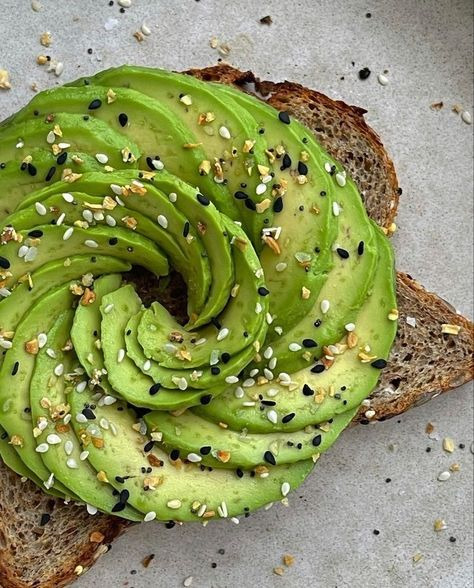
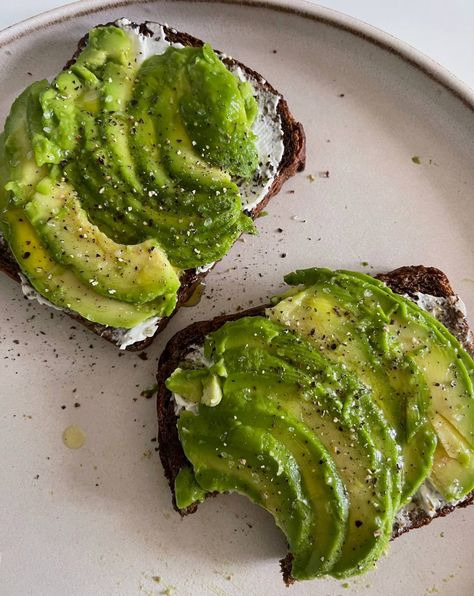
first of all, what are superfoods, and why are they so beneficial to our health? are those that in addition to feeding us have beneficial properties for health and are 100% natural, their origin is mainly vegetable and raw consumption, have a high content of fiber, minerals, proteins and vitamins, many of this help strengthen the immune system and promise the extension of a long healthy life.
and these are some of the foods you should incorporate into your diet.
goji berries: high in vitamins and minerals
acai berries: beneficial for overall health and boost performance. high in antioxidants, vitamins, minerals, and essential fatty acids.
chia seeds: high in vegetable fiber, omega-3 fatty acids, and high-quality protein.
ginger: it is attributed with properties against digestive discomfort and headaches. it also has an anti-inflammatory effect.
avocado: high in healthy fats, antioxidants, it has numerous micronutrients among which are vitamins C, vitamin B5, and vitamin K.
green tea: accelerates metabolism, detoxifying.
matcha: rich in antioxidants, polyphenols, and EGG, responsible for helping to protect against heart disease, helps regulate blood sugar, and accelerates metabolism.
quinoa: high protein concentration, rich in fiber and vitamins.
spinach: high concentrations of vitamins C and A, flavonoids, omega-3.
curcuma: increases serotonin production, helps regulate menstrual cramps and headaches.
walnuts: source of omega-3, protects our heart and cholesterol, we will get protein, vitamin E, fiber, healthy fats and lots of energy.
broccoli: very low caloric intake, rich in vitamin A and beta-carotene (a great antioxidant), vitamin C, fiber and folic acid.
seaweed: all are alkalizing and a good source of dietary fiber, antibacterial, anti-inflammatory, and antioxidant properties. contain healthy fatty acids and provide plenty of calcium, iron, and iodine.
and many more…! i am getting into the world of healthy eating to incorporate it into my day-to-day and I will continue to bring you posts related to this so that you also know about it and you can have a really healthy diet 🤍
this article has been written with the help of different sources.
#green juice girl#that girl#it girl#pink pilates princess#clean girl#health and wellness#healthy#healthy living#healthy weight loss#health#healthy tips#wellness#healthy diet#healthy lifestyle#healthy life tips#levelup#leveling up#level up journey#weightlosstips#lose weight#dream life#dream body#dream girl#self esteem#self care#self improvement#self love#self growth#self gratitude#divine feminine
2K notes
·
View notes
Text
How I Manage Food Costs as a Feedist
Preface: I often see people in this community post about struggling with food insecurity and managing food costs. These are just some tips that have helped me when I was down to the last few dollars and needed to eat for a few weeks. I understand circumstances are different for everyone, and some people struggle even with this level of food security, I have been there. My intention is to help.
With food prices still high—often due to profit gouging—I’ve found ways to manage my food budget, and the secret is simple: **eat at home!** Growing up in extreme poverty with two working parents, eating at home was pretty much our only option, aside from takeout once every few months. My parents taught me the value of home cooking, and while it takes time to develop essential skills, Making sauces, learning how to prep and clean ingredients, cooking veggies, preparing meats, etc., once you have them, there’s a whole world of recipes within reach.
Here’s how I manage food costs, and how you can too:
1. Weekly/Monthly Shopping Essentials
Start with the basics—items you’ll need to shop for regularly to cover your meals for a week or two. Building a pantry depends on the storage space you have, but here are some key ingredients to keep on hand:
- Milk (1 to 2 gallons, depending on your choice—I go with 1%)
- Eggs (18 count)
- Bread (1 loaf) (I also recommend tortillas as they last longer than bread and can be used for nearly any bread needs)
- Rolls or Croissants (If you shop at a bulk store, you can get a dozen for $6.)
- Fruits: Change with the season, but apples, oranges, and grapes are solid year-round choices. In the summer, throw in some berries and stone fruit.
- Veggies for Prep: Stick to simple, versatile veggies like green bell peppers, zucchini, onions, potatoes, and chilies.
- Butter: Unsalted sweet cream butter is my favorite! Go for sticks instead of tubs for a better per-unit cost.
- Leafy Greens: A bag of spinach or romaine hearts
- Cheese: Shredded cheese works best and if you want to save more, buy a block and slice or shred it yourself.
These staples give you a variety of flavors, textures, and nutrition to build meals around, whether you’re whipping up sides, salads, or more complex dishes.
2. Protein, Protein, Protein!
Protein is an essential part of a healthy diet, but you don’t need to overdo it or overspend. I’ve found that chicken and tofu are some of the most affordable and versatile protein sources available (unless you’re hunting your own!). Both freeze well and can be used in a variety of recipes with different seasonings and marinades.
You can also look at beef, but stick to lean beef and fish as you do not want to pay for fat that will not end up in your food.
3. Shelf-Stable Items to Buy in Bulk
Buying in bulk can be a game changer, especially if you stock up on shelf-stable items. If you’re short on storage space, invest in an airtight tote to keep things organized. Start with common essentials like:
- Flour (Good ole AP with cover you most of the time)
- Sugar
- Baking Powder
- Baking Soda
- Brown Sugar
- Cooking Oil (I go for olive oil and canola oil)
These staples are the foundation of countless recipes and, when stored properly, can last for months or even a year.
4. Season Early, Season Often
Spices are what make food magical! You don’t need fancy brands—stick with basics that offer single-ingredient profiles. My go-to spices are:
- Salt
- Pepper
- Garlic Powder
- Onion Powder
- Thyme
- Oregano
- Paprika
- Cumin
- Cinnamon
- Chili Powder
- Vanilla Extract
- Bouillon Cubes
- Red Pepper Flakes
These spices will give you all the flavor you need to create a variety of meals without breaking the bank.
5. Canned Goods: The Unsung Hero
Canned goods are a staple in my kitchen. They offer consistent quality, low prices, and a long shelf life. Plus, they’re great for backup when fresh ingredients are low. Some key canned items to keep on hand are:
- Pinto Beans
- Crushed Tomatoes
- Tomato Paste
- Tomato Sauce
- Boiled White Potatoes
- Herring or Sardines
- Tuna
- Fruit Cocktail
- Peaches
- Pears
- Broth or Stock
These ingredients can help you create filling and versatile meals on a budget.
6. Where You Shop Matters
The store you shop at can make a huge difference in food prices. Here’s how to stretch your budget even further:
Bulk Stores: Invest in a membership at places like Sam’s Club, Costco, or BJ’s. The $100 yearly fee is usually paid for in savings after just a few trips. Protein, especially beef and fish, is almost always cheaper in bulk stores.
Walmart and Aldi: These stores are great for extras like frozen veggies, fresh produce, dairy items, and baked goods. Their prices are hard to beat!
Hope this helps and feel free to reblog or comment with your own tips and tricks!
Stick to Your List: One of the easiest ways to overspend and waste food is by shopping without a plan. Make a list, and stick to it. This will help keep your budget in check and prevent unnecessary purchases.
By following these steps, you can keep your food costs down while still eating healthy and delicious meals. The key is planning ahead, shopping smart, and keeping a well-stocked pantry!
103 notes
·
View notes
Text
LOWERING YOUR CORTISOL LEVELS: THE MAIN STRESS HORMONE

Hi lovelies! If you didn’t know, cortisol is the main stress hormone of your body. Cortisol is a good thing for our bodies, it manages how our body uses carbs, fats or proteins, keeps inflammation down, regulates your blood pressure, increases glucose, controls your sleep cycle and boosts energy for when you have high levels of stress.
However, your body can produce too much unnecessary cortisol which is when it can start taking a toll on us, leading to
Anxiety or depression
Headaches
Heart diseases
Memory problems
Trouble staying focused
Digestive complications
Sleeping complications
Weight gain/loss
and more!
below the read more, there’s ways to lower and regulate our cortisol levels <3
getting adequate sleep
Prioritising and optimising our sleep is already beneficial for us, but it can help with lowering our cortisol levels. To make the most of your sleep, have an winding down routine, sleep and wake at similar times everyday, limit your caffeine intake(including soft drinks!) and reduce your screen time before you go to bed.
Moderate intensity exercise
Too intense exercise or no exercise, can increase the levels of cortisol but intense exercise usually has a temporary effect. It helps with managing our stress better and promotes better sleep which also helps with lowering your cortisol levels.
Practise deep breathing and meditation
This time to clear our minds, helps stimulates our resting & digest system in us. (Parasympathetic nervous system). You can do this wherever, whenever.
Eating a nutritious diet
Only you know what’s the best diet that suits your lifestyle, so I won’t say much about this, but make sure that you’re getting quality nutrition in your body.
Take your supplements
Make sure you talk to your doctor before taking any supplements! Before you consider taking any supplements, do some individual research first.
#prettieinpink#glow up#glow up era#becoming that girl#green juice girl#clean girl#pink pilates princess#girlblogger#self improvement#wellness#wellness era#health#physical health#self love#self care#self development#girl blogger#just girly things#girl blog#self healing#healing#healing journey
766 notes
·
View notes
Text
💖 NUTRITION & WELLBEING EDITION - 10 WEEKS UNTIL 2025 - GLOW UP SERIES [WEEK 10] - 💖
So we’re 10 weeks till 2025, the new year is fast approaching, your energy levels are in the gutter and despite mentally wanting to change your life there’s just something keeping you stuck. You wake up and it’s the same story different day, tired, hungry, moody as hell.
While you might mentally want to change your life, your body needs to be on board and to do that it’s gona need the right foods, drinks and nutrients to have you functioning at your optimal level. Taking drastic action when it comes to changing your diet is how you’re going to see drastic results in your energy levels, productivity and overall wellbeing…
The foundations:
🛌 SLEEP: All those late night movies before bed, Netflix and chill, love-is-blind binging needs to stop immediately. You need a set bed time and you need to be consistent. Waking up and going to sleep at the exact same time every single day. I recommend 10pm - 6am or somewhere around there.
🥱 Sleep with your mouth closed. Use mouth strips from amazon if you dribble, snore, or struggle to sleep properly - breathing through your mouth is most likely the culprit. It’s not natural and disturbs natures rhythm which is breathing through your nose. Mouth strips have been a game changer for me, and highly recommended.
🚫 No screen before bed. This is obvious but those doom scrolling morning and nights are over. Switch it off, read a book, pray, meditate, do what you need to. This is about resting your body before bed so you can sleep well and function at your best the next day.
Sleep supplements: Magnesium oil spray or tablets before bed
🍴 FOODS & DRINKS: 2 litres water MINIMUM per day. Absolutely no alcohol for the next 10 weeks. Strict diet of vegetables, fruits, protein and healthy fats, high quality meats and fish. More herbs into your food. Seeds, whole grains such as Chia, Flaxseed, Pumpkin seed, Bulgar wheat. More pre-and-probiotics. Sprouted veggies. Snack on nuts. No sweets, no cakes, no carbs. No bread, no pasta, no rice, no gluten. No nothing that is not a whole food, or from the earth. You are your own doctor when it comes to food, so you will know what is best for you. Above is the closest diet to nature and has changed my life. Eating vegetables in season. Removing western foods, removing vegetable oil, only drinking structured water, herb teas, and freshly pressed veg juices. Changing your diet might mean you stop eating out, you cut the takeouts, you spend your evenings researching meal preps for Keto, or healthy diet. Your life will completely change when you start feeding your body ALIVE foods, instead of nutrient deficient, processed food that keeps you craving more. Yes you are going against the grain. You will be the minority, but what are the alternatives? Stay binging? Stay eating crap? Stay feeling crap?
Supplements:
Chronium, Berberine for support with blood sugar
D3 + K2, B12, Vitamin C 1000mg, Turmeric, Probiotics,
DIM, Milk Thistle, Selenium, Iodine Drops, Omega 3, Mega GLA for women’s health.
Other:
Get full blood panel done to see any deficiencies
Invest in a continuous glucose monitor from Amazon - see how your body is responding to foods you are eating in real time.
🏃🏽♀️EXERCISE: There is no way around this. You need to do some fucking exercise. Even if you start with 10k steps per day. Just do it. Once you’ve switched up your diet you absolutely WILL have more energy. Join a gym, set the intention, put reminders on your phone affirming you ARE someone whoo does exercise and works out. Leave your gym clothes out before bed. Set yourself up to win. Find a friend or someone to work out with. Look on YouTube for a workout if the gym is not possible. Just try your best. This is a mind over matter. ~You got this.
🧘🏽♀️ Finally…STRESS FREE LIVING…
You can eat all the healthy foods, do your 10k steps but if you are involved in a stressful life, those stress hormones are going to come and f**k shit up. You have to remove stress where possible. This is the NUMBER one health destroyer. Stress literally makes is ill. It depletes your energy, exhausts you, and keeps you in survival - not much different to the animals living in the wild. Your life can be so stress free once you realise you are actually in control of a lot more than you realise. Blocking HIM. Saying no to hanging out with HER. Hanging up the phone. Removing yourself from the drama. Quitting your job. Changing your course. Deleting social media. Switching off the news permanently. Distancing yourself. There is SO much you can do to remove stress. But it’s completely on you. You have to take control if you are serious about changing your life.
That’s all for this week! Next week more advice on your pre-2025 glow-up.
#manifestyourreality#levelupjourney#lawofattraction#manifesting#growthmindset#levelup#manifest#manifestingmindset#levelup confidence lawofattraction powerofthemind#adviceformefromme#glow up#glowup#project 2025
82 notes
·
View notes
Text

When it comes to building muscle and fueling your body for intense workouts, a well-balanced diet is key. While chicken and fish often take centre stage in gym-goers' meal plans, mutton, particularly fresh mutton, deserves a spot in your gym diet. In this blog, we'll explore why mutton should be a staple in your fitness-focused nutrition, and how you can conveniently buy goat meat online. Discover the benefits and elevate your workouts with the goodness of mutton!
0 notes
Text
How to follow a Mediterranean Greek diet
The Mediterranean diet naturally expands throughout the coastal countries of South Europe, North Africa and the Middle East but there are some small differences between their cuisines. So here I am writing specifically about the Greek version of the Mediterranean diet, known for its delicious, natural flavours and its significant health benefits.

Eat daily:
Olive oil: the pillar, the liquid green gold of the Mediterranean Greek diet. Olive oil should be used ideally exclusively for all purposes. It's dressing salads, it's used in cooking and in fact it's traditionally what is used in frying too. Replace all types of oils, butter and margarine with olive oil even when making pastries. The only problem here is that outside of the Mediterranean basin olive oil can be pricey, however that's the foundation the diet is based on. If you are interested in following the traditional Greek diet for taste or health purposes, it is good to really incorporate olive oil in your daily cooking. If it’s not possible to afford buying olive oil all the time (although you could balance it out by not buying other oils and butter), a non-Greek-typical but equivalent alternative could be avocado oil. However, I doubt avocado oil or any other oil can remotely compare to olive oil in health properties, taste or in any other positive quality 🫒
Vinegar: Just like olive oil, vinegar is a very important ingredient and is also used in natural remedies However, it can hurt a sensitive GI tract if consumed in large portions. A little bit of it added to meals frequently is very healthy. Apple cider vinegar is also very loved and used in salads often 🍇
Vegetables: no portion can be too much (wild greens, garlic, onions, cauliflowers, cucumbers, eggplants, beets, peppers, spinach, artichokes, zucchini, peas, lettuce, the list never ends). Tomatoes and broccoli are recent additions to the Greek diet however they were integrated perfectly to the Greek cuisine. In general, all vegetables can be enjoyed freely with some moderation in the potatoes, especially when fried 🥗
Fruits: grapes, berries, apples, melons, cherries, figs, prunes, sour cherries, peaches, pomegranates are the most historically loved fruits in the Greek diet. Since the middle ages citruses like the orange, the lemon and the mandarin are more and more loved. Greeks nowadays use lemon almost more than vinegar and both have become integral components of the Greek diet. Obviously, tropical fruits like, say, banana, mango, grapefruit are not present in the traditional Greek diet, however all fruits are good fruits and you can enjoy them freely 🍎
Legumes. Eat freely to the tolerance of your body. Legumes can be too heavy for some GI tracts. Legumes are a great source of protein and fibre. Choose brown lentils, white beans, fava beans, chickpeas, giant beans and black eyed peas the most 🫘
Nuts, seeds: almonds, walnuts, sunflower seeds, peanuts etc. Eat as much as your body can take, because everybody is different 🥜
Mushrooms: mushroom it up! A great healthy way to have them is grilled with herbs and plain or apple cider vinegar dressing 🍄🟫
Whole grains: this is the traditional way to eat grains. Brown bread, oats, whole wheat pasta 🌾
Fish and seafood: find and eat them fresh. Instead of buying them deep frozen from the big markets, find local fish stores if your place is coastal and has them. Eat both large but especially small and medium sized fish. Some fish like salmon and tuna should ideally not be consumed daily due to their high levels of mercury and fats 🐟🎣🍤
Herbs and spices. Feel free to use as much as you want however if you are interested also in the flavours of the Greek diet besides the health benefits, a tip is that Greek dishes do not contain extremely hot spices 🌿
Water: A lot of water daily and, mind you, plain clear mineral water. No flavoured water, definitely not sparkling water and ideally no other liquids in place of the water. I mean, sure you can have liquids but you should ALSO have plain water 💧
Eat a few times per week:
Poultry: Poultry and lean meats entered the Greek cuisine mostly after the Middle Ages however they are nowadays enjoyed as part of the Greek Mediterranean diet because they are tasty and healthier than other types of meat. Chicken has become especially popular in the Greek cuisine. Other birds are the pheasant, the quail, the turkey and more sparsely the duck 🍗
Eggs: eggs are healthy and should be consumed a few times per week but not daily because they can cause a rise in cholesterol levels 🥚
Dairy: Greeks LOVE dairy products, especially the various types of cheese, however they are often irritating to the GI tract and they are linked with rises in the level of inflammation in the body. This is why you should ideally limit them to a few times per week. One exception is the yoghurt, which is fermented and can be perhaps consumed more frequently due to its beneficial properties. Important note: if you want to follow the Greek diet, you should ideally opt for milk and other dairy products from goats and sheep! Cow milk is not traditionally used in the Greek cuisine often and sheep and goat milk are significantly healthier and more nutritious. The only drawback is the stronger smell, however if you can get past that, it is strongly advised to switch to those instead of cow milk. Another note: what is known as “Greek yoghurt” in western countries is not in fact a true Greek yoghurt. What you call Greek yoghurt is to us simply a strained yoghurt, a yoghurt from which the whey has been removed. Sometimes in western markets (and in Greek “modern” dessert yoghurt products) butterfat and powdermilk is added to them and they are mostly made of cow’s milk. Again, a traditional Greek yoghurt is made of sheep, goat milk or a mix of both and is unstrained. It also has a trademark thickened skin on its top (dunno if this is the actual term lol) which is in fact the part of the yoghurt that contains the most nutrients and personally it’s the tastiest part of the yoghurt but apparently it is not for everyone. As an example, a study showed that an unstrained sheep yoghurt has more protein, more omega-3 fatty acids and minerals yet fewer calories and fats than a strained cow yoghurt 🍦🧀
Wine: in small portions, like a small glass up to a few times per week and always in combination with your meal. You don’t drink it to get hammered, you drink it for the health benefits it has in very moderate quantities and for the reasonable mild euphoria it causes before it becomes harmful. The GI tract is linked to the brain and is detrimentally influenced by negative emotions. This is why it is important to try to be in a good mood, relaxed and peaceful when you sit down to eat. A sip of wine now and then can be good for that 🍷
Eat once per week or ideally less:
Red meat like pork or beef. In fact, beef should be the one most avoided not only because it is indeed the rarest of the common meats used in traditional Greek cuisine but also because you can’t separate the fat from the meat as easily as with pork. To follow the Greek style in a healthy way opt for goat, then lamb or pork and make beef your most occasional meat dish 🥩
Processed meats should be eaten rarely. If you are in a mood for it though, opt for Greek style sausages with herbs in or bacon at most. Cured meats like ham are better to be avoided but turkey is the healthiest of them. They are not a part of a traditional Greek cuisine though.
Refined grains can be enjoyed weekly but should not replace whole grains
Pastries. What’s new, pastries are not ideal for health. However, if you are yearning for something sweet, if you want to keep it healthy as much as possible in the “Greek way”, opt for desserts made of healthy ingredients like honey, nuts, olive oil and fruits. Chocolate came to Greece in the 19th century, however it has become an integral part of confectionery since then. Opt ideally for dark chocolate, combined with nuts or fruits such as oranges and prunes. Greeks especially love chocolate combined with nuts.
Soft and sugary drinks. Avoid them overall, especially the processed products in the markets. If you need a sweet drink really bad, you can keep it traditional by making your own sweet lemonade, sour cherry, pomegranate etc drink at home. You could also enjoy small quantities of lemon or mastic liquors which are good for digestion.
BONUS TIPS & PHILOSOPHY:
Try to find mastic if it’s available where you live. The mastic is a resin produced from the mastic tree, a species endemic to the Greek island of Chios and a small part of the opposite coast of Turkey. It has numerous beneficial properties, especially for digestion and gut health, and it combines them with a very pleasant fresh and sweet flavour. You can find it in gums that boost digestion, in drinks, in pastries and even in non-edible products like toothpastes. Learn about it and give it a try, no matter if you are interested in following Greek diet or not.
Greek cuisine does not go berserk on as many ingredients as possible (however Greeks typically add more ingredients than, say, Italians and perhaps fewer than the Middle Easterners). Don’t worry about adding as many foods and nutrients in one single dish. The most important thing in Greek cuisine philosophy is to pick the finest ingredients. Avoid deep frozen or precooked and processed ingredients. Pick whole fruits and vegetables from your local small grocery store. For example, don’t buy a watermelon slice in a zelatin bag from the supermarket. Take the whole freaking watermelon home. You heard me right. It’s heavy, yes, but you would be surprised how much tastier and healthier it is this way. Go to the butcher for meat. Go to the specific cheese shop for cheese. Go to the fisherman for fish and seafood. Go to the pastry shop and get a nice dessert instead of buying candies from the market.
Remember that in moderation you can eat most of the foods you desire, especially if they are not processed foods. There is nothing about the Greek diet that is restrictive in terms of its philosophy - historically the intake of various foods was regulated only based on availability and price. There are no foods you should limit due to any perception of them being “bad” and you should never feel guilty the moment you are actually having the food. Just work slowly and progressively by building gradual appreciation for healthy foods and prize less nutritious foods as occasional taste bud rewards.
As said above, a good mood is crucial when you sit down to eat. In the history of the Greek society this translated into eating with friends and / or family, maybe with the occasional sip of wine, ideally in a pleasant environment and always taking your time with your food. If some of these are less feasible than others, try alternatively to improve the setting in which you eat, to eat in an environment that calms you down. Schedule your meal so that you won’t eat in anxiety or hurry, if this is possible. Think of pleasant memories and feel grateful for your food. Cheers! Or, you know, εις υγείαν!
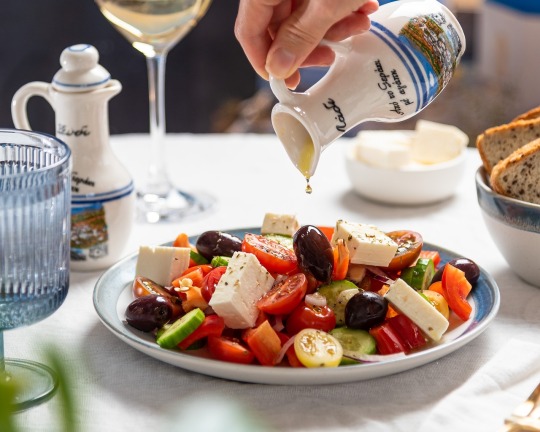
102 notes
·
View notes
Note
How do I truly become a pink Pilates princess on a budget?
Pink Pilates Princess 101
✧・゚: *✧・゚:* ✧・゚: *✧・゚:* ✧・゚: *✧・゚:* ✧・゚: *✧・゚:*
When I think of a pink pilates princess, I think of a girly person that romanticized their life in terms of wellness! a lot of people find the phrase annoying but i think it’s fun and cute! Here’s some things you can do to feel more like a pink pilates princess 💞

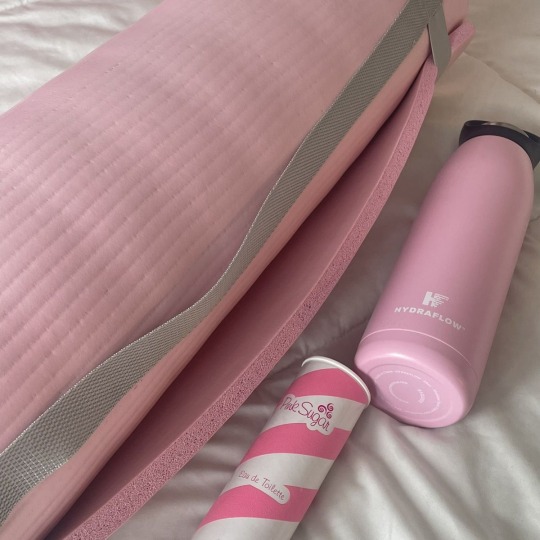

pic credit: all 3 pics from me posted on my pinterest @ nallyssajones
1. Doing pilates!

There’s mat pilates (only need a mat) and reformer pilates (using a reformer machine). Going to classes multiple times a week can be a tad expensive, so an alternative would be:
A) Signing up for paid subscriptions that have detailed classes for e.g; Alo moves, Pilates anytime, glo etc.
B) Following videos from youtubers that do mat pilates. My fave channels are; Move with Nicole, Sanne Vloet, Dansique fitness (she mostly does hitt pilates videos)
* Yoga is another amazing way to get movement in and feel connected to your body and spirit.
* Go on a hot girl walk! Going on mini walks around your neighborhood or even your house allows you to get some steps in daily.
2. Eating well!

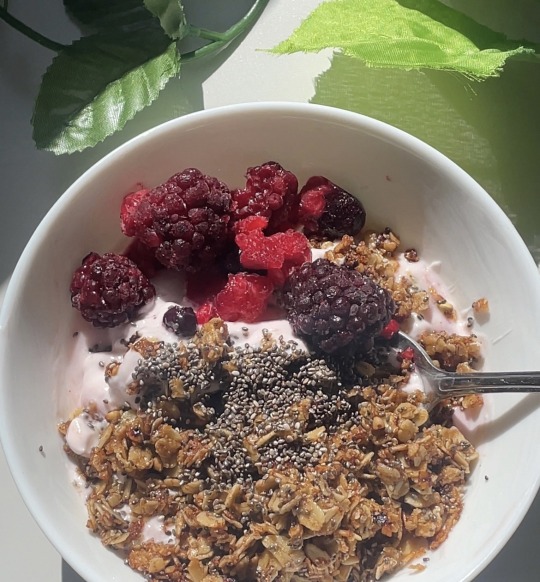
pic credit: my pics posted on my pinterest @nallyssajones
This is different for everyone but here are some ideas that you can add to your diet;
- Drinking green juice
- Try out yogurt bowls! It's my favourite breakfast food because it's easy to make and can be very nutritious depending on what I put into it. I like to add greek yogurt, a nice granola, matcha powder, frozen and fresh berries, pomegranate, ground flax and almonds🫐🍓
- Increasing protein intake. A lot of people have tried to eat 1 g per each lb that they weigh daily and have felt really good. My fellow anemic girlies, please increase your protein intake if you can!
- Taking your vitamins/supplements! get a blood test done to see what you’re deficient in and research supplements that might be helpful for you personally.
3. Finding cute workout+lounge sets

(pic credit: from @ lyssithadoll on ig and twitter)
Working out and going out in cute loungewear and workout sets can make you feel really nice and girly! I like to thrift nice quality brands like lululemon or even purchase specific pieces from depop and poshmark! Amazon is a good place to find sets as well but I would recommend buying high quality secondhand pieces💞 Some good brands to look out for are lululemon, alo yoga, halara and girlfriend collective.
4. Get cute exercise equipment

pic credit: my picture posted on my pinterest and ig @ nallyssajones
Get pink workout equipment if you’d like! Marshalls, dollarama, and amazon sell workout equipment that you can get for $5-$20! I got the pink fila mat in the pic above from marshalls for $19.99:) Here are some equipment ideas:
- yoga mat
- yoga strap
- wrist/ankle weights
- 5 lbs dumbbells
- gym bag
*these things aren’t needed btw! just ideas if you’d like to have more equipment.
5. Practice self care
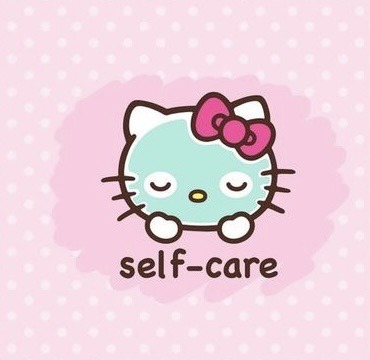

You can do whatever self care that you'd like but here are some examples that you can incorporate into your life:
- Take a relaxing bath (the book "ritual baths" has amazing bath ideas
- Engage in your favourite hobbies (sports, reading, watching a tv show etc.)
- Spend time with your loved ones
- Take care of your skin and have a routine down. You do not need 15 products but even adding a serum or a spot treatment to your routine can improve your skin!
***************************************************************************************************
I hope that you liked this post! This is all for fun and anyone can be a pink pilates princess 🧚🏾💞
#my pictures#my post#pink pilates princess#answered#girly girl#self care#wellness#prettygirlmission#my blog post#pink text
156 notes
·
View notes
Text
Worldbuilding
Made a new fantasy world in my spare time today, populated it with fantasy races.
Premise of the story: An elf chef who runs the best restaurant in the area gets his ingredients by diving into the local dungeon. His restaurant is the best not only because of his fantastic cooking skills and quality ingredients, but also because he can serve anybody that comes through his doors; each of the races has different dietary needs and finds different things poisonous, and he can cook for anyone.
One day, he's in the dungeon, and he falls down into a lower level nobody's been to in AGES. Thing is, though, there's a human living there, a biologist who's been studying the dungeon ecology for centuries, and the last human alive—all others were wiped out centuries ago due to a plague, and she's only alive because she's been living in the dungeon.
Main story arc is this guy trying to figure out not just what she can eat, but what she'd LIKE to eat, without killing her in the process.
Yes this is inspired by Dunmeshi. What of it.
Races are:
Humans (extinct)
Elves
Faunlings
Halflings
Orcs
Dwarves
Brounies
Gnomes
Elves
A camouflage species, their colors depend on the environment they're in. A snow elf would be pale white, a wood elf shades of green and brown, a dark elf (as in, lives underground) stone gray with jet black hair, and so on. Knife-point ears. Average height: 5'8"
Diet: Vegetarian, can't process meat at all, regardless of source.
Faunlings
Deer-like people, ranging visually from elves with horns to satyr-like. They're all one species, despite individual variation.
Diet: Opportunistic carnivores, they CAN eat meat, but mostly eat plants; can't process milk or most sugars past infancy. Average height: 4'10"
Halflings
NOT hobbits. They're small people, deathly pale and young-looking in their base form, with nub horns on their heads. Their appearance changes depending on who they live nearest, from their build to their coloration—a halfling living near wood elves might get taller and coppery with pointed ears, while a halfling near faunlings might have furrier legs, dappled shoulders, and longer horns, etc. Average height: varies wildly
Diet: Obligate ovivores, eat almost exclusively eggs when young and need lots of protein. Depending on who they live near, they'll eventually adapt to local cuisine and build up poison tolerance, but forcing that adaptation to go too quickly can send them into shock.
Orcs
Cat eyes and feline fangs, big and muscular. Like elves, they camouflage based on location, but they tend to be more colorful overall. Average height: 6'10"
Diet: Heavily meat-based diet, they eat most meat raw. Highly lactose intolerant, may occasionally eat plants, but can't process grains.
Dwarves
Short and stocky. Dark blueberry purple-blue by default, will temporarily turn pale on parts of their bodies that are exposed to light for a few hours. Sunlight sends them into temporary hibernation and petrification, making them statue-like. On cloudy days, they're lethargic, and on moonlit nights, their skin gets a little harder, with white patches depending on the strength of the moonlight. Average height: 3'9"
Diet: They have a tolerance for poisons that most races would die over, but they can't stand most acids. Citric acid in particular is poisonous to them. Cavern-based diet.
Brounies
THESE are the hobbits. Short and humanlike, with long, fur-tipped tails. Usually monochrome in color scheme, leaf-point ears. Average height: 3'2"
Diet: Can't process plant fibers properly, all plant matter must be cooked to break it down. Mostly raw pescatarian.
Gnomes
Even smaller than brounies, humanlike, with round-edged pointed ears and generally plump bodies. Average height: 2'4"
Diet: Vegan, with HIGH poison tolerance, they actually need some poisons to live. Mushrooms and fruit make up much more of their diet than leaves do.
107 notes
·
View notes
Text
Some scary rhetoric gets unpacked upon learning the body holds onto fat after you try to force it all off.
Realizing the college freshman 10, 15, 20 or whatever is likely weight gained as a result of people being able to eat what they want and how much they actually need to eat for the first time in their lives.
Thinking of all those girls who gained a lot of weight after high school or university and realizing they might've been actually starving themselves to stay thin, but they're healthier now.
Knowing weight gain can just be a result of genetics or a change in medication, but wondering how much is it a result from people's disordered eating patterns that were created and nurtured in their formative years. Terrified of the answer in a way that being thin was more important than having the necessary calories to function and properly develop.
The aisle full of protein bars used to be a single shelf. If it was about health, there'd be an equal variety of fiber bars because the average american diet severely lacks it. If it was about health, why push the idea that any food which tastes good is bad and unhealthy? What does that say about the quality of food or supplements that diet companies can sell you?
If it was about achievable goals, why are weight loss companies paying people who have always been thin to advertise their products? Before there'd be the illusion of someone who was big that got smaller with photo evidence in commercials, but even that much effort to lie is gone.
If diet culture was successful it wouldn't be a multi million dollar industry. It'd gradually fade out of mainstream use like the cure for smallpox. Instead it grows every year because snake oil has gotten much easier to sell.
34 notes
·
View notes